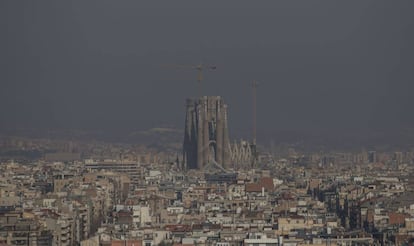Air pollution falls by 38% in Spanish cities due to pandemic
According to a new report, nitrogen dioxide levels dropped significantly between March and October as a result of the coronavirus lockdown and move towards remote working


The fall in traffic over the past eight months, due to both coronavirus lockdowns and the rise of remote working, has reduced air pollution in Spain’s cities to levels far below anything seen in the last decade. That’s according to a new report by conservation group Ecologists in Action.
According to the report, official air quality measurements from 26 cities show that nitrogen dioxide (NO2) levels dropped 38% between March and October, compared to the 10-year average for this period. But the positive trend was curbed over autumn, and Ecologists in Action warn that if Spain does not change its mobility habits and reduce car use, air pollution will soon rise back to pre-pandemic levels. Indeed, in November, air pollution in Barcelona had already exceeded these levels, although this was not included in the report, which only covers data from March to October.
When there are fewer cars, there is better air quality, and when the traffic comes back, it gets worseAntonio Castaño, coordinator of Ecologists in Action report
NO2 is a compound that is harmful to humans and closely linked to motorized traffic as well as industrial and domestic boilers. During the first state of alarm, which was declared in mid-March and expired at the end of June, levels of NO2 fell by more than 50% in Spain’s 80 most populated cities, according to data from the European Environment Agency (EEA). The Ecologists in Action report shows that this drop continued in the summer from June 21 to August 31, when levels remained 28% below the average for the decade, and were maintained in September and October coming in at 29% below the average.
“The NO2 levels recorded during the first state of alarm are the lowest for the same period in the last decade in all the cities analyzed,” the report states. This means that levels remain well below the annual limit value of 40 micrograms per cubic meter (40μg/m3) set by the World Health Organization (WHO), a threshold which is often exceeded in cities such as Barcelona, Bilbao, Granada, Madrid, Málaga, Murcia, Palma and Valencia.

“The reduction of NO2 in the cities has been a general trend since March, which means that meteorology has not been a determining factor since this has varied in the different cities,” explains Antonio Castaño, the report’s coordinator. “Rather, it is down to the decrease in activity, particularly with regard to land transportation. Now that we are seeing an upturn in mobility, pollution is increasing again. The resumption of activity is leading to the deterioration of air quality, because the mobility model has not changed.”
NO2 is a compound that is harmful to humans and closely linked to motorized traffic as well as industrial and domestic boilers
Indeed, from June 21, when the first state of alarm ended, the report detects notable differences between the various cities. For example, in Cádiz and Málaga, where national tourism is strong, pollution levels were only a respective 1% and 13% below average. But in A Coruña, Vigo and Palma de Mallorca, cities that depend more on foreign tourism, which was brought to a standstill by the pandemic, pollution fell by more than 40% with respect to the average of previous years. This was also seen after summer: Málaga recorded close to average levels, with only 4% less NO2 registered in September and October, suggesting that air pollution in the city will return to pre-pandemic levels, while in Oviedo, measurements show a decrease of 47% this autumn compared to the same period during the previous decade.
Moreover, since October there have been more peaks in NO2 pollution. “Although the monthly averages are still below the annual legal limit value, there is a clear upward trend in most cities,” the report notes.
Castaño believes the conclusion is evident. “When there are fewer cars, there is better air quality, and when the traffic comes back, it gets worse,” he says. “Also, public transportation is losing users to private transportation, so we are already seeing an increase in pollution. This year we have gone below the WHO hazard levels, but this has been exceptional and is not sustainable over time. To make long-term change, we need to reduce traffic, have fewer cars and to travel more by foot and bicycle, to increase teleworking and to reduce the number and duration of trips using private transportation.”
English version by Heather Galloway.









































